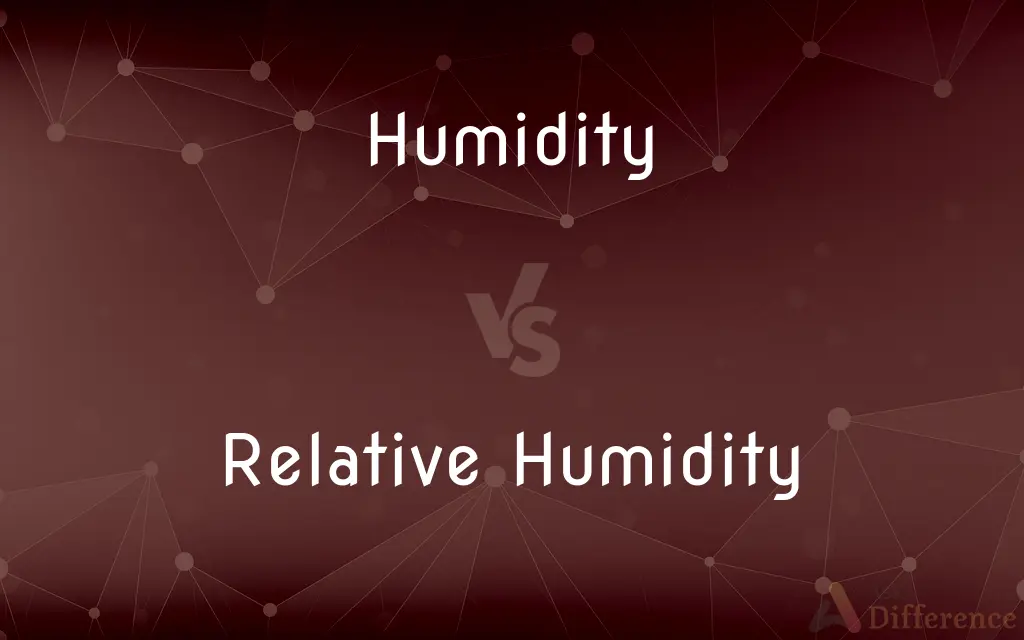Humidity vs. Relative Humidity — What's the Difference?
By Tayyaba Rehman & Maham Liaqat — Published on September 18, 2024
Humidity measures water vapor in the air, while relative humidity expresses this as a percentage of the maximum possible at a given temperature.

Difference Between Humidity and Relative Humidity
Table of Contents
ADVERTISEMENT
Key Differences
Humidity, in general, refers to the amount of water vapor present in the air. It's a broad term that encompasses various measures of water vapor content, without specifying how it relates to the air's capacity to hold moisture at a certain temperature.
Relative humidity, on the other hand, is a specific measure, defined as the ratio of the current absolute humidity to the highest possible absolute humidity at that temperature, expressed as a percentage. This makes relative humidity a more useful metric for understanding how "humid" it feels, as it takes temperature into account.
Humidity can be measured in absolute terms, such as grams of water per cubic meter of air, whereas relative humidity is always a percentage. This percentage indicates how close the air is to being fully saturated with water vapor, which varies with temperature. As the temperature increases, air can hold more water vapor, and vice versa.
The significance of relative humidity lies in its impact on comfort, health, and various processes. High relative humidity can make warm temperatures feel hotter, as it hampers the body's ability to cool itself through evaporation of sweat. In contrast, humidity (without the relative qualifier) simply informs us about the quantity of moisture in the air, without direct implications for human perception or comfort.
Both humidity and relative humidity are crucial for weather forecasting and climate study. While humidity levels are important for understanding the absolute moisture content of the air, relative humidity provides insight into the likelihood of precipitation, dew, or fog formation, which are dependent on the air reaching saturation.
ADVERTISEMENT
Comparison Chart
Definition
Measures the water vapor content in the air.
The percentage of water vapor in the air compared to the maximum it can hold at that temperature.
Units
Grams per cubic meter (g/m³) or kilograms per cubic meter (kg/m³).
Percentage (%)
Dependence on Temperature
Absolute measure, not directly affected by temperature.
Highly dependent on temperature, as it compares the current humidity to the maximum possible at that temperature.
Main Use
Indicates the amount of moisture in the air.
Indicates how saturated the air is with moisture, impacting comfort and weather phenomena.
Perception & Comfort
Does not directly indicate comfort levels.
Directly correlates with human comfort and the perception of "humid" conditions.
Compare with Definitions
Humidity
The concentration of water vapor present in the air.
The humidity in the rainforest is much higher than in the desert.
Relative Humidity
Determines how comfortable or uncomfortable we feel.
A relative humidity of over 60% can make it feel much hotter.
Humidity
Can be quantified as absolute humidity.
The absolute humidity today is 14 grams per cubic meter.
Relative Humidity
Influences weather predictions and climate models.
Relative humidity readings are crucial for predicting rain.
Humidity
Important for determining dew point and precipitation.
Humidity levels help forecast foggy conditions.
Relative Humidity
Can lead to condensation when air cools to its dew point.
High relative humidity inside a house can cause windows to fog up.
Humidity
Affects physical and chemical processes.
Humidity impacts the drying rate of paint.
Relative Humidity
The amount of moisture in the air compared to what it can hold at a certain temperature, expressed as a percentage.
The relative humidity must be 100% for fog to form.
Humidity
A general term for the moistness in the air.
High humidity can make a cool day feel muggy.
Relative Humidity
Varies throughout the day with temperature changes.
Relative humidity is usually higher in the morning.
Humidity
Dampness, especially of the air.
Humidity
Relative humidity.
Humidity
Dampness, especially that of the air.
Humidity
The amount of water vapour in the air.
Humidity
Moisture; dampness; a moderate degree of wetness, which is perceptible to the eye or touch; - used especially of the atmosphere, or of anything which has absorbed moisture from the atmosphere, as clothing.
Humidity
Wetness in the atmosphere
Common Curiosities
Can humidity be higher than relative humidity?
They measure different aspects; humidity refers to absolute moisture content, while relative humidity is a percentage, so they're not directly comparable.
How do temperature changes affect relative humidity?
As temperature increases, air can hold more water vapor, decreasing relative humidity if the moisture content remains constant, and vice versa.
What is humidity?
Humidity is the amount of water vapor in the air.
Why is relative humidity important?
It affects human comfort, weather forecasting, and the likelihood of precipitation and dew.
How does high humidity affect our perception of temperature?
High humidity can make it feel hotter because it reduces the effectiveness of sweating to cool the body.
What unit is humidity measured in?
Absolute humidity is measured in grams per cubic meter (g/m³) or kilograms per cubic meter (kg/m³).
What happens when relative humidity is low?
Low relative humidity can lead to dry skin, irritation, and discomfort, as well as increase static electricity.
What does 100% relative humidity mean?
It means the air is fully saturated with water vapor and cannot hold any more, leading to the possibility of precipitation.
Does relative humidity affect all areas equally?
No, its impact varies with climate and temperature; for example, high relative humidity is more oppressive in hot climates.
What is relative humidity?
Relative humidity is the ratio of the current amount of water vapor in the air to the maximum amount it could hold at that temperature, expressed as a percentage.
What's the difference between dew point and humidity?
The dew point is the temperature at which air reaches 100% relative humidity and begins to condense, while humidity measures water vapor content.
Is relative humidity the same at all temperatures?
No, it varies with temperature; the same absolute humidity results in different relative humidities at different temperatures.
How do you measure humidity?
Humidity can be measured using a hygrometer or similar devices.
Can relative humidity impact health?
Yes, both high and low relative humidity can affect health, including respiratory issues and dehydration.
Why does relative humidity change throughout the day?
It changes due to variations in temperature and moisture content in the air.
Share Your Discovery

Previous Comparison
One Piece Toilet vs. Two Piece Toilet
Next Comparison
Romper vs. JumpsuitAuthor Spotlight
Written by
Tayyaba RehmanTayyaba Rehman is a distinguished writer, currently serving as a primary contributor to askdifference.com. As a researcher in semantics and etymology, Tayyaba's passion for the complexity of languages and their distinctions has found a perfect home on the platform. Tayyaba delves into the intricacies of language, distinguishing between commonly confused words and phrases, thereby providing clarity for readers worldwide.
Co-written by
Maham Liaqat












































